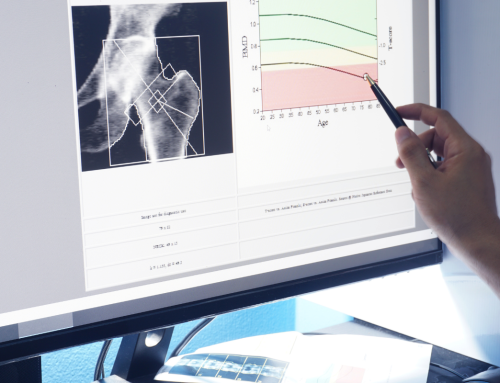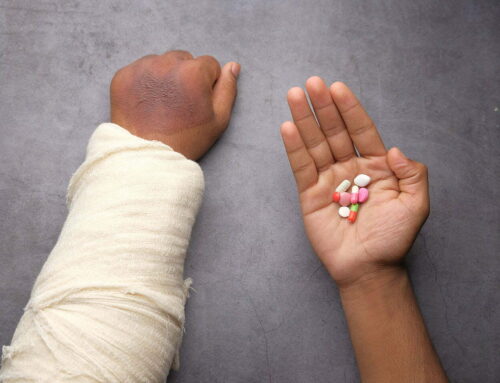
You might have left a recent doctor’s appointment with a new word on your mind: osteopenia. It means your bone density is lower than it should be, and hearing those words can feel unsettling. Maybe you’re picturing brittle bones or wondering what this means for your future health.
Fortunately, there are straightforward, practical ways to support your bone health. This guide explains what low bone density means, what to ask your doctor, and how options like Marodyne LiV can help you protect your bones moving forward.
TL;DR
- Low bone density means your bones are weaker than ideal but not yet osteoporotic. It’s a warning sign—not a reason to panic.
- Talk to your doctor about your T-score and whether you should calculate your CAROC score to understand your fracture risk.
- Focus on nutrition, balance, and gentle movement to help your bones stay strong and supported.
- At-home tools like Marodyne LiV use low-intensity vibration to stimulate bone and muscle.
- Small changes can make a big difference in preventing fractures and maintaining independence.
What Does Low Bone Density Mean?
A diagnosis of low bone density (also called osteopenia) means your bones have begun to lose strength but haven’t reached the threshold for osteoporosis. It’s a warning sign that your bone health needs more support and extra attention.
Think of it as a checkpoint. Your bone mass is lower than average for your age and gender and now is the time to take action to reduce your risk of future problems like fractures.
What to keep in mind:
→ Low bone density raises your risk of fractures, but it doesn’t mean they’re inevitable.
→ With early action, many people maintain strong, stable bone health for years.
→ The most effective prevention happens before severe symptoms or injuries appear.
Talk with Your Doctor About What Comes Next
Once you’ve had a bone density scan and received a diagnosis of low bone density, your next step is to have a more detailed conversation with your healthcare provider. The goal is to understand your personal risk factors and develop a tailored prevention plan.
Here are a few useful things to ask about:
- Your T-score and what it suggests about your risk for future bone loss or fractures.
- Other contributing factors, such as medications, family history, or hormonal changes.
- Whether medication is recommended or if you can start with lifestyle changes alone.
- If a FRAX score would be helpful. This score combines your bone density with other health details to estimate your 10-year fracture risk.
In Canada, many healthcare providers use a tool called the CAROC score to assess your risk of fracture. It combines your bone density results with risk factors such as age, sex, and fracture history. Learn more about how CAROC helps assess fracture risk.
Prioritize the Nutrients That Support Bone Strength
Nutrition plays a major role in maintaining healthy bones, especially when your bone density is already below ideal levels. Certain nutrients are key players in how your bones form, repair, and retain strength over time:
- Calcium: Found in dairy products, leafy greens, almonds, and fortified plant-based milk.
- Vitamin D: Helps your body absorb calcium efficiently. Safe sun exposure and supplements can help fill gaps.
- Magnesium + Vitamin K2: Both support calcium metabolism and contribute to bone structure and density.
- Protein: Necessary for building bone tissue and maintaining muscle mass, which helps with balance and fall prevention.
If you follow a restricted diet or have a digestive condition, it may be worth consulting a registered dietitian. They can help identify whether you're getting enough of the nutrients your bones rely on and how to fill any gaps without overcomplicating your routine.
Explore Safe Movement That Supports Bone Health
Certain types of physical activity can help maintain bone mass and stimulate bone remodeling. But not all movement is equal, and the goal here isn’t intensity… it’s consistency and safety.
The most beneficial types of exercise include:
✓ Weight-bearing activities. Walking, hiking, dancing, or climbing stairs—anything that gently loads your bones through your feet and legs.
✓ Resistance training. Using light weights, resistance bands, or bodyweight exercises can help build strength and protect bone structure.
✓ Balance and stability work. Practices like Tai Chi, yoga, or even standing on one foot can improve coordination and reduce your risk of falls.
⚠️ Note: If you’ve already experienced a fracture, have known spinal issues, or are at higher risk of falling, some exercises may not be appropriate without supervision. This is a good time to consult a physiotherapist familiar with bone health.
Try Gentle At-Home Tools to Support Your Bones
If you’re looking for an accessible, drug-free way to support your bones at home, consider Marodyne LiV, a non-invasive medical device that uses low-intensity vibration (LiV) to stimulate bone cells and promote skeletal strength.
Here’s how it can help:
- Encourages bone formation and helps reduce bone loss.
- Supports balance, stability, and muscle responsiveness, which are key to fall prevention.
- Non-invasive and drug-free, making it a good fit for early-stage bone loss.
- Requires just 10 minutes per day with no complicated setup or physical exertion.
🔗 Learn how Marodyne LiV supports bone health
Be Proactive About Fall Prevention
Most fractures in people with low bone density happen because of a fall. That’s why supporting your balance and reducing fall risk is just as important as protecting your bone strength.
A few practical ways to make your environment (and your body) more stable:
🧹 Clear the path. Remove tripping hazards like loose rugs, electrical cords, or cluttered walkways.
💡 Light the way. Install nightlights in bedrooms, hallways, and bathrooms to reduce the risk of nighttime falls.
👓 Stay sharp. Keep up with vision and hearing checks. Even small changes in sensory input can affect your stability.
🏠 Use helpful supports. Handrails, grab bars, and non-slip mats in the bathroom can make a big difference, especially when you're tired or navigating at night.
🧘♀️ Get a balance check-up. A physiotherapist can assess your balance and coordination and recommend exercises to help you feel more steady and confident on your feet.
Fall prevention doesn’t have to mean big changes. Small adjustments can add up to a safer home and a stronger sense of control.
Keep an Eye on What’s Changing
Bone loss often happens quietly, but so does improvement. Paying attention to subtle changes over time can help you stay motivated, informed, and confident in your care plan.
A few things worth checking in on:
→ DEXA scan results, typically every 1–2 years (or as recommended).
→ Muscle strength and balance. Are everyday movements feeling steadier?
→ Any changes in medication, especially if your doctor adjusts your treatment plan.
→ How you’re feeling overall, physically and mentally.
If you’re using a tool like Marodyne LiV, it’s helpful to track your usage and note any changes in posture, coordination, or daily stability. Even small shifts can be meaningful signs that your bones, and your balance, are on the right track.
There’s a Lot You Can Do From Here
Low bone density is a warning worth paying attention to, but it doesn’t have to lead to fear or drastic action. It’s a chance to reassess, refocus, and take action that supports your health long before fractures or limitations set in.
With practical guidance, consistent habits, and accessible tools like Marodyne LiV, you have options that don’t rely on drastic measures or uncomfortable trade-offs. Small, consistent changes now can mean stronger bones, better balance, and greater independence later.
👉 Curious whether Marodyne LiV could be part of your plan? Connect with our team in Canada to learn how Marodyne LiV supports strength and stability without high-impact exercise or medication.




 Black Friday → Christmas Sale! Save $300 + Free Shipping
Black Friday → Christmas Sale! Save $300 + Free Shipping 